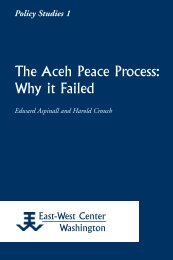Constructing Papuan Nationalism: History, Ethnicity ... - ScholarSpace
Constructing Papuan Nationalism: History, Ethnicity ... - ScholarSpace
Constructing Papuan Nationalism: History, Ethnicity ... - ScholarSpace
- No tags were found...
Create successful ePaper yourself
Turn your PDF publications into a flip-book with our unique Google optimized e-Paper software.
58 Richard Chauvelsuch as these continued to be an issue as <strong>Papuan</strong> resistance to Indonesiagrew after 1963. For example, <strong>Papuan</strong>s identified the OPM, initially ledby Permenas Awom in the Bird’s Head Region and in Biak by NoahRumaropen, as a Biak-led organization. Other anti-Indonesian <strong>Papuan</strong>sfeared that if the OPM was successful, independence would be the prerogativeof the Biak leadership. Saul Hindom detected the influence ofKoreri in the conviction among Biaks that the leadership of the strugglefor independence should come from Biak. He proposed the establishmentof a representative body with the authority to achieve independence andunite all the <strong>Papuan</strong> organizations with the one objective of independence(Hindom n.d.).The leaders of PARNA in the early 1960s were among the best educatedof their contemporaries and the first to begin the move from themilieu of their own ethno linguistic group into a broader pan-<strong>Papuan</strong>sphere. Not only were they among the first to call themselves “<strong>Papuan</strong>s,”but they also helped create the ideological framework for being <strong>Papuan</strong>today. Rupert Stasch’s study of the Korowai, who live in a relatively isolatedrural community, provides insights into the way people are becoming<strong>Papuan</strong> today. If the leaders of PARNA wereamong the first <strong>Papuan</strong>s, then the Korowai areamong the more recent members. The Korowailands are located in the southern interior lowlandsof Papua some two hundred miles north ofthe district capital of Merauke. The speakers ofKorowai language number about 4000. The presenceof the Indonesian state there is still limited.As late as the 1990s, police and civilian representativesof the government visited the Korowai lands only about once a year,though a more permanent but still erratic presence was provided by highland<strong>Papuan</strong> schoolteachers and a Papua-born Javanese health nurse.These were not the only outside contacts, however. For example, highlandDani airstrip workers and Digul church functionaries had been livingamong the Korowai for twenty years. Furthermore, non-<strong>Papuan</strong> traders,many from Sulawesi, operated in the area selling mass-produced commoditiesand buying forest products. Nevertheless, in recent years theKorowai have acquired a keen sense of being “<strong>Papuan</strong>,” and their involvementin the Indonesian administrative system has been an important partof that process.Rupert Stasch’s study ofthe Korowai…providesinsights into the waypeople are becoming<strong>Papuan</strong>
















